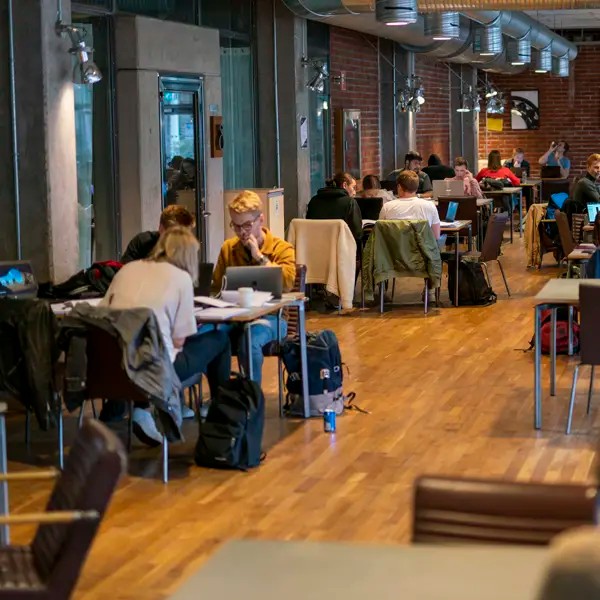
Sound and vibration properties are critical for how we perceive our surroundings, from vehicles such as trains and passenger cars to outdoor, indoor, and virtual environments. A lack of forethought in these areas can lead to serious health effects, sleep disturbance and stress, impacting upon people's well-being and public health. But well-designed environments can yield beautiful acoustic properties — in concert halls and theatres, naturally, but also in everyday buildings such as offices and shopping centres. This master's programme, therefore, is for engineers who want to create a better acoustic world.
Sound and vibration master's programme at Chalmers
Contribute to a sustainable built environment and support the development of products and services with the right sound and vibration properties. The master's programme in Sound and vibration at Chalmers is unique in Sweden and with its breadth within acoustics engineering one of very few in Europe and worldwide.
Sound and vibrations are a fundamental part of our daily life. Visual and auditory stimuli represent our main source of information from the outer world. Therefore, it is no surprise that sound and vibration properties are critical for the experienced quality of environments or products such as high-speed trains, road vehicles, outdoor and indoor environments, sound reproduction systems, virtual environments, or communication systems.
The lack of appropriate sound and vibration quality leads to dysfunctional products and environments. In the very end, it even may lead to adverse effects such as annoyance, sleep disturbance, and stress, impacting people's well-being and health.
Therefore, the master’s programme Sound and vibration is aimed towards engineers who want to contribute to a "better acoustic world" by creating products with high sound and vibration quality as well as functional and sustainable environments that offer space for recreation, supporting people's well-being and health. To prepare for such challenging tasks, the programme offers a broad education in the interdisciplinary field of acoustics incorporating fields as diverse as physics, mechanics, physiology, signal processing, psychology, and electrical engineering.
The programme structure allows for a specialization in different areas such as noise control engineering, architectural acoustics, environmental acoustics, or audio technology. Cooperation with other master's programmes inside Chalmers and at Scandinavian and European universities enables the range of specialisations to be further extended.
The master's programme has a strong focus on the link between theory and practical application. The focus is on identifying and solving problems by using experimental investigations, physical reasoning, analytical models, and numerical methods. This is accomplished through project work in small groups guided by experienced teachers, as well as through access to experimental facilities especially suited to this purpose.
I am more aware of how sound and vibration affects our lives. Whenever I go anywhere, I think about the acoustic treatments whether it's a product, a room or outside

Topics covered
The subjects of acoustics, acoustic engineering, noise control and audio technology are fundamental areas in the Sound and vibration master’s programme. The courses included in the programme plan handle topics such as technical acoustics, sound planning, musical acoustics, vehicle acoustics and building acoustics.
Career
As a specialist in sound and vibration, you will have the possibility to work in many different sectors reaching from the vehicle industry to audio technology.
The educational profile in the Sound and vibration master's at Chalmers enables you to find professional opportunities as a specialist all over the world, especially in Europe where there is a strong need for specialists in the field. Typical examples of career opportunities as a specialist in sound and vibration can be found in:
- Acoustic consultancies working with product development, environmental noise, architectural acoustics or building acoustics. Traditionally, the building industry does not have its own specialists in the area but relies on consultants.
- The automotive industry has its own departments dealing with sound and vibration properties.
- In the communication industry, where sound is important for the quality of products and services.
- Audio equipment manufacturers that deliver both software and hardware for consumers and for professional customers.
- Public organizations concerned with environmental issues, housing, traffic planning and health.
Graduates from the programme can be found at companies such as Volvo cars, Volvo trucks, Sony Ericsson, WSP, AFRY, SWECO, Brekke & Strand, Cochlear, Sigma connectivity, Zound industries.
Research
The Division of Applied acoustics at Chalmers is one of the leading acoustics laboratories in Europe. Having initiated and coordinated numerous projects that were funded by the European Commission, it is a strong international player in the research field. This includes research on tyre/road noise, railway noise, urban sound planning or a spearheading international research project on acoustic levitation. We have good relationships with all of the well-established acoustics laboratories in Europe (e.g. ISVR in Southampton, UK, ITA in Berlin, Germany, and INSA in Lyon, France), including regular exchange on both student and PhD levels.
Industrial cooperation partners include Facebook Reality Labs in the USA, the Swedish vehicle manufacturer Volvo Trucks (AB) as well as companies in Europe such as Fiat, Volkswagen, and Continental, and the railway company Deutsche Bahn. We also work together with major consultancies, research institutes and public organisations in Sweden and abroad (Technical Research Institute of Sweden (RISE), VTI, Trafikverket, WSP, AFRY, Müller BBM in Germany, and CSTB in France).
Find out more about research in Architecture and civil engineering
Requirements

How to apply - From application to admission
This is a step-by-step guide on how to apply for a Master's programme at Chalmers University of Technology.

